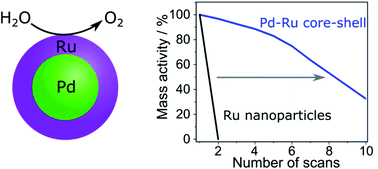Our official English website, www.x-mol.net, welcomes your feedback! (Note: you will need to create a separate account there.)
Pd–Ru core–shell nanoparticles with tunable shell thickness for active and stable oxygen evolution performance†
Nanoscale ( IF 6.7 ) Pub Date : 2018-08-03 00:00:00 , DOI: 10.1039/c8nr03341b Lucy Gloag 1, 2, 3, 4, 5 , Tania M. Benedetti 1, 2, 3, 4, 5 , Soshan Cheong 3, 4, 6, 7 , Richard F. Webster 3, 4, 6, 7 , Christopher E. Marjo 3, 4, 6, 7 , J. Justin Gooding 1, 2, 3, 4, 5 , Richard D. Tilley 1, 2, 3, 4, 5
Nanoscale ( IF 6.7 ) Pub Date : 2018-08-03 00:00:00 , DOI: 10.1039/c8nr03341b Lucy Gloag 1, 2, 3, 4, 5 , Tania M. Benedetti 1, 2, 3, 4, 5 , Soshan Cheong 3, 4, 6, 7 , Richard F. Webster 3, 4, 6, 7 , Christopher E. Marjo 3, 4, 6, 7 , J. Justin Gooding 1, 2, 3, 4, 5 , Richard D. Tilley 1, 2, 3, 4, 5
Affiliation

|
For Ru nanoparticles to be effective oxygen evolution reaction (OER) catalysts an approach is needed that stabilizes Ru while retaining high activity. Here, we present a synthesis for Pd–Ru core–shell nanoparticles with tunable shell thicknesses between 0.3–1.2 nm. The Pd core stabilizes the Ru shell to increase the stability by up to 10×, while maintaining the high current densities of pure Ru nanoparticles. Results show that the activity and stability of the nanoparticles is highly dependent on the nanoparticle shell thickness, with thin Ru shells and full coverage of the Pd core being vital for increasing both activity and stability.
中文翻译:

Pd-Ru核-壳纳米粒子具有可调节的壳厚度,从而具有主动和稳定的放氧性能†
为了使Ru纳米颗粒成为有效的氧释放反应(OER)催化剂,需要一种在保持高活性的同时稳定Ru的方法。在这里,我们提出了一种Pd-Ru核壳纳米粒子的合成方法,其壳厚度在0.3-1.2 nm之间可调。Pd核稳定了Ru壳层,从而将稳定性提高了10倍,同时保持了纯Ru纳米颗粒的高电流密度。结果表明,纳米颗粒的活性和稳定性高度依赖于纳米颗粒壳的厚度,薄的Ru壳和Pd核的完全覆盖对于提高活性和稳定性都至关重要。
更新日期:2018-08-03
中文翻译:

Pd-Ru核-壳纳米粒子具有可调节的壳厚度,从而具有主动和稳定的放氧性能†
为了使Ru纳米颗粒成为有效的氧释放反应(OER)催化剂,需要一种在保持高活性的同时稳定Ru的方法。在这里,我们提出了一种Pd-Ru核壳纳米粒子的合成方法,其壳厚度在0.3-1.2 nm之间可调。Pd核稳定了Ru壳层,从而将稳定性提高了10倍,同时保持了纯Ru纳米颗粒的高电流密度。结果表明,纳米颗粒的活性和稳定性高度依赖于纳米颗粒壳的厚度,薄的Ru壳和Pd核的完全覆盖对于提高活性和稳定性都至关重要。


























 京公网安备 11010802027423号
京公网安备 11010802027423号